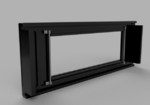Being of modest financial means, yet having hobby metal and woodworking shops as well as a 3D printer, I tend to make something if I need it.
While I do have a Cambo SC 4x5, I hate the limitations of the 617 back fitted on a 4x5 camera. I also can't and would not pay the price shen hao is asking for their 617 cameras. To that end, I'm designing a convertible field camera to shoot 120 roll film, with dedicated magazines for 6x17, 6x12, and 6x9 images. Maybe 6x7 so I can crop to 6x6 and 6x4.5 without too much waste.
I've mostly designed the first (617) roll film back except for a few minor details like the closure method to join the two piece backs. I'm using a technique that I often use to build complex geometries that could not otherwise be printed without a ton of supports and having to do a lot of clean up. I print many of the parts split in the middle to create two flat printing surfaces, and then I glue then together in a 3D printed clamping jig where the external clamping surfaces mirror the part geometry. The back of the magazine will be a lamination of 3 separate layers, which will help maintain a flat film plane, and allow for dark slide slot that is able to be fully lined with light trapping material.
This method will also allows me to have a complex features facing the interior of the roll film back like the film registration ridge that sits proud of the magazine back, and raised ribs and film support rails for greater rigidity while maintaining critical dimensions, as well as recessed flats for locating and mounting two film pinch rollers.
I was going to design a ratcheting lever film advance, but really I don't need such fineries, but I did include a one way ratchet assembly to assure that I dont have a brain fart and roll the film the wrong way ever. With age I'm finding I have lapses in memory. The good thing is that 3D printing is very inexpensive and I can modify the design quickly by just cutting out the middle of the magazine in fusion 360 to create new components and bodies.




 Reply With Quote
Reply With Quote



Bookmarks